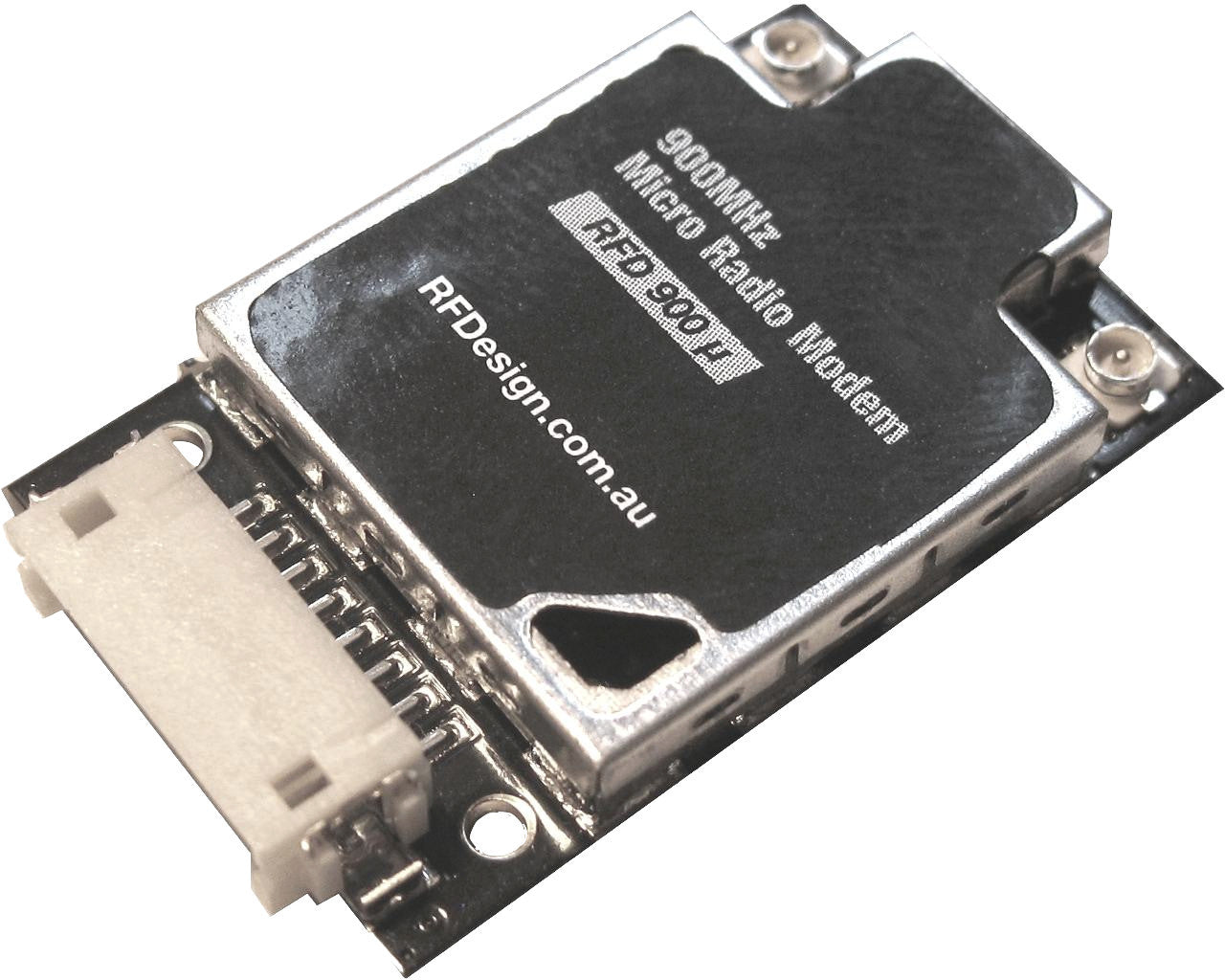Description
MPN: MODEM-RFD900u
Manufacturer: RFDesign
**RFD900u Modem has reached its end of life and will be discontinued**
REPLACED BY THE RFD900ux
Features:
- The smallest, lightest and most sensitive diversity switched modem on the market.
- AES128 hardware accelerated encryption for secure data links (* SOFTWARE IMPLEMENTATION IN PROGRESS *)
- Long range >10km depending on antennas and GCS setup
- 2 x u.FL RF connectors, diversity switched.
- 2 x user controllable I/O pins.
- 100 mW (+20dBm) transmit power.
- Integrated transmit low pass filter to reduce interference to other co-located radio links.
- Latest technology pHemt, high gain > 24dB, high linearity Low Noise Amplifier (LNA).
- Receive SAW filter for blocking out of band interference.
- Open source firmware SiK / tools, field upgradeable, easy to configure.
- Multipoint software capability with MP SiK (V2.x)
- 128kB flash, 8kB RAM - more space for customisation.
- Compatible with 3DR / Hope-RF radio modules.
- License free use in Australia, Canada, USA, NZ
Interfaces:
- RF : 2 x u.FL/IPX connectors
- Serial: Logic level TTL (+3.3v nominal, +5v tolerant)
- Power: +5v, ~300mA max peak (at maximum transmit power)
- GPIO: 2 General purpose IO (Digital, ADC, PWM capable).
- Connector: DF13, 8 way connector (interface cables available from RFDesign)
Specifications:
- Frequency Range: 902 - 928 MHz (USA) / 915 - 928 MHz (Australia)
- Output Power: 100mW (+20dBm), controllable in 3dB steps
- Air Data transfer rates: 4, 8, 16, 19, 24, 32, 48, 64, 96, 128, 192 and 250 kbit/sec ( User selectable, 64k default )
- UART data transfer rates: 2400, 4800, 9600, 19200, 38400, 57600, 115200 baud ( User selectable, 57600 default )
- Receive Sensitivity: <-111dBm at 9.6kpbs, <-107 dBm at 64kbps, <-105dBm at 129kbps (air serial speed)
- Size: 19.0 mm (wide) x 30.4 mm (long) x 4.5 mm (thick) - Including RF Shield and maximum connector extremeties
- Weight: 2.7g
- Mounting: 2 x M1.5 screws
- Power Supply: +5 V nominal, (+3.5 V min, +5.5 V max), ~190mA avg TX +20dBm, ~230mA peak TX +20dBm, ~77mA RX
- Temp. Range: -40 to +85 deg C
Software / GCS Support:
The software solution is an open source development called "SiK" originally by Mike Smith and improved upon by Andrew Tridgell and RFDesign. A boot loader and interface is available for further development and field upgrade of the modem firmware via the serial port.
Most parameters are configurable via AT commands, Eg. baud rate (air/uart), frequency band, power levels, etc., please see the 3DR wiki for commands below for now.
V2.x firmware has been updated to support multipoint networking on the RFD900.
V1.x (non multipoint) is suitable for point to point links - the sourcecode is located at: https://github.com/RFDesign/SiK
The user manual / datasheet is here : RFD900u Datasheet
RFD900/u configuration tool: http://files.rfdesign.com.au/tools/
RFD900/u binary firmware repository: http://files.rfdesign.com.au/firmware/
3DR/RFD900/u compatible configuration tool : http://vps.oborne.me/3drradioconfig.zip
Wiki for the 3DR radios (RFD900/u has same commands): http://ardupilot.org/copter/docs/common-rfd900
Integrated support for configuring the RFD900/u radios is supported by APM Planner, with other GCS solutions in development.
The default settings are at 57600 baud, N, 8, 1, and 64k air data rate.
Software features include:
- AES128 hardware accelerated encryption (* Software Implementation in progress *)
- User controllable I/O pins
- Frequency hopping spread spectrum (FHSS)
- Transparent serial link
- Point to Point, or Multipoint networking
- Configuration by simple AT commands for local radio, RT commands for remote radio
- User configurable serial data rates and air datarates
- Error correction routines, Mavlink protocol framing (user selectable)
- Mavlink radio status reporting (Local RSSI, Remote RSSI, Local Noise, Remote Noise)
- Automatic antenna diversity switching on a packet basis in realtime
- Automatic duty cycle throttling based on radio temperature to avoid overheating
Compliance:
The RFD900u is designed to be compliant with the following standards:
- FCC Part 15.247 (Frequency hopping and digitally modulated intentional radiators)
- AS/NZS 4268:2012 (Radio equipment and systems - short range devices)
The modem is designed for system integrators who will integrate the modem into their own projects and product prototypes. The user is responsible for compliance with local regulations for radio transmitters.

